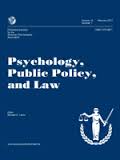Most Americans do not have a complete understanding of their Miranda rights. In fact, only about 3% are aware of their continuing legal rights. Even those who are able to recall the Miranda warning show misconceptions about its meaning. This is the bottom line of a recently published article in Psychology, Public Policy, and Law. Below is a summary of the research and findings as well as a translation of this research into practice.
Featured Article | Psychology, Public Policy, and Law | 2013, Vol. 19, No. 4, 432-442
General Knowledge and Misknowledge of Miranda Rights: Are Effective Miranda Advisements Still Necessary?
Author
Abstract
Miranda warnings are the Constitutional keystone in protecting the right of custodial suspects against self-incrimination. Although deeply embedded in police practices and popular dramas, a fair question is whether these warnings have outlived their usefulness. If the public is already conversant with the Miranda warnings, then such advisements may represent little more than a pro forma ritual that merits only a cursory recitation to satisfy a Supreme Court’s requirement. Using jury pools as a cross-section of the community, participants were (a) asked for their free recall of Miranda warnings and (b) assessed for their knowledge and misknowledge of Miranda rights and associated police practices. Successful recall varied for the first four components but dropped dramatically for the fifth Miranda component with failures exceeding 97% for ongoing legal rights. Using participants’ self-appraised knowledge of Miranda, it became evident that those claiming little knowledge performed poorly on Miranda recall with high numbers of Miranda misconceptions. In general, the data indicate a continued need for Miranda warnings or other effective means for communicating rights. They shed light on public policy issues in addressing Miranda misconceptions, which extend far beyond the advisements per se.
Keywords
Miranda warnings, Miranda rights, Miranda misconceptions, Miranda Quiz
Summary of the Research
This research study investigated the degree to which members of the general American public are able to recall the Miranda warnings and examined the extent of the public’s knowledge or misknowledge about these constitutional protections. “This study provides the first descriptive data on free Miranda recall and Miranda misconceptions for a substantial cross-section of the public in a predominately urban population” (p. 434). Members of the Dallas County jury pool were recruited at the Dallas County Courthouse to participate in this study. Participants (n = 420) were asked to provide free recall of the Miranda warning and to complete a measure used to assess Miranda misconceptions. In addition, participants were asked to provide a self-appraisal of their Miranda knowledge. Researchers examined the congruence between self-appraisal of knowledge and recall / misconceptions of the Miranda warning.
Participants were divided into three groups on the basis of their self-appraisal of Miranda knowledge (low, medium, high). The three groups varied widely in their free recall of the Miranda warning, but showed a general pattern of knowledge consistent with self-appraisal (i.e., those who self-appraised as having a high degree of knowledge showed higher free recall for most components of the Miranda warning). However, the group that self-appraised as having the lowest degree of knowledge were perhaps the most accurate in their estimation, especially since those who self-appraised as having high knowledge demonstrated a lack of awareness of their lack of knowledge (i.e., meta-ignorance; you don’t know what you don’t know).
The Miranda warning consists of 5 components. Examination of free recall for each of these components shows that 87% of the sample recalled the right to silence (component 1); 80% recalled the right to counsel (component 3); 73% recalled that statements made can be used as evidence (component 2); 48% recalled the right to free legal services (component 4); and less than 1% recalled the notion of continuing legal rights (component 5). In addition, it should be noted that recall of the right does not necessarily mean that the understanding of that right is accurate.
In terms of misconceptions of Miranda rights, this research showed a weak linear trend whereby those who self-appraised as being more knowledgeable had fewer misconceptions of the Miranda rights. It is important to note, however, that the sample demonstrated numerous misconceptions of these rights (and even those in the group that self-appraised as having high knowledge showed misconceptions of these rights). Almost one-quarter (24%) of the sample did not realize that their right to silence was safeguarded by the Constitution, and about 20% of the sample believed that their continued silence could be used against them. Most of the sample understood that any statements they made could be used as evidence against them; however, more than one-third (34%) believed that statements designated as “off the record” could not be used against them and 21% believed that statements provided without a signed waiver could not be used as evidence against them. In addition, the majority of the sample (61%) was not aware of the need for precise language when requesting an attorney and 28% mistakenly believed that interrogation could continue until an attorney arrived. Legal terminology was a particular stumbling block, with more than 40% of participants unable to understand the phrase “withdraw your waiver.”
Finally, this research noted, “rampant misperceptions were readily apparent regarding permissible police practices,” with 57% of the sample being unaware that police could accuse them of crimes that never occurred, 48% being unaware that police could provide inaccurate or blatantly false information about eyewitness identifications, and 35% believing that they had some legal recourse in response to police deception (p. 437).
Translating Research into Practice
This research was conducted to answer the question of whether the American public is sufficiently knowledgeable about their Miranda rights that providing notification of these rights is redundant or unnecessary. The results indicate that the clear answer is no; the American public does not have a complete understanding of these rights. In fact, misconceptions about these rights occur even amongst those who are able to recall the warnings as well as amongst those who believed that they had complete knowledge of their rights.
An important point about this research is that these results were compiled from a cross-section of community members eligible to serve as jurors. The education level of this sample was high (averaging a few years of college education) and these participants were not being asked to recall their rights under stressful circumstances, such as a custodial interrogation. These results, therefore, represent a best possible scenario for understanding Miranda rights. Most individuals who are being informed of their rights are not highly educated and typically consider custodial interrogation to be a stressful event, which we know can impair cognitive functioning. Thus, as Rogers and colleagues note, this data can be considered upper-bounded, meaning that they represent higher levels of recall and lower levels of misconception than would occur in the actual population of interest (i.e., individuals undergoing custodial interrogation). So, if well-educated individuals in a non-stressful situation demonstrate misconceptions about their Miranda rights, how much worse does it get for those who are not as well educated and who are being informed of their rights under stressful circumstances?
With respect to how these results might be used in practice, Rogers and his colleagues write:
“In spite of the disconnect between Miranda recall and misconceptions, findings from the current [study] suggest that the absence of free recall could signal the need for closer scrutiny with respect to Miranda misconceptions. Pending cross-validation, attorneys and their investigators could simply ask Mirandized suspects for their free recall of a Miranda warning. Suspects recalling only one or two of the first four components are likely to fall into the high-error group, which was found to have more than one in three Miranda misconceptions. This simple screen can be completed in less than one minute and potentially assist in identifying those suspects with both deficient Miranda knowledge and a substantial risk of compromised Miranda reasoning. Such information could be used by defense counsel and their staff as part of the decision process regarding the merits of seeking Miranda consultation.” (p. 440)
Other Interesting Tidbits for Researchers and Clinicians
This research also presented data on Miranda misconceptions for four criterion groups classified in terms of self-appraisals (low v. high) and Miranda recall (uninformed v. knowledgeable) as well as discriminant function analysis models for classifying low-error and high-error groups with respect to demographic variables and need for cognition.
Join the Discussion
As always, please join the discussion below if you have thoughts or comments to add!








